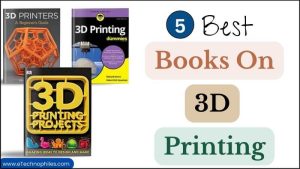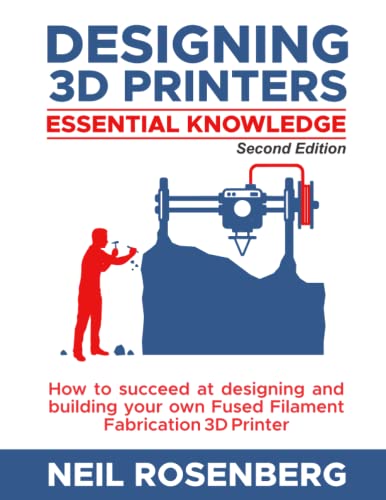Last updated on March 28th, 2024 at 12:24 pm
This technology is advancing every day at an accelerated pace. If you want to explore this new world, you need a solid guide. Or if you are trying to get a better understanding of 3D printing you might need a helping hand, or rather a helping book. Just for you, we have created a list of the 11 best books on 3D printing on the market right now.
Our top recommendations:
Which is the best book on 3D printing for Kids?
DK’s 3D printing projects is one of the best books on 3D printing for kids. It covers everything from the basics to advanced topics, such as designing your own 3D-printed objects.
The book includes clear instructions and plenty of diagrams to help guide readers through each project. In addition, the book is filled with fun and interesting facts about 3D printing technology.
Which is the best Book on 3D printing for Beginners?
This technology has come a long way in recent years, and it shows no signs of slowing down. For those who are new to the world of 3D printing, 3D Printing For Dummies by Richard Horne and Kalani Kirk Hausman is the perfect introduction.
The book starts with the fundamentals and gives clear, step-by-step instructions for using a 3D printer. With its clear and concise prose, “3D Printing For Dummies” is an essential guide for anyone interested in this rapidly evolving field. Furthermore, the authors provide advice on selecting the ideal 3D printer for your needs and budget.
Which is the best Advance 3D printing book?
The 3D Printing Handbook: Technologies, design, and applications is a guide to 3D printing, design, and applications for Experts in this field. It begins by discussing the basics and then moves on to more advanced topics such as printing with multiple colors and materials, printing large objects, and printing medical implants. It also includes a section on design principles and case studies of successful applications.
3D Printing Projects
Want to get your child excited about 3D Printing? Then this book will be your ideal partner. Because in just 96 pages, this book will teach them the basics of 3D printing. Apart from that, the follow-along projects will help them in understanding the concepts better.
Key Features (Projects):
- Design a personalized stamp
- Make a coat hook
- Prepare a treasure box
- Make a beautiful star lantern
- Phone stands for your phone
- Design an animal-shaped keychain
- Very easy-to-follow language
Ideal for: Kids aged 9 to 12 years
Not ideal for: Adults
Number of pages: 96
Number of chapters: –
3D Printers: A Beginner’s Guide
Get your hands dirty with this amazing book on 3D printing. Even if you don’t have any prior knowledge of 3D printing you can buy this book with your eyes closed. This book is going to cover everything on 3D printing.
Key Features:
- A solid overview of concepts and techniques
- Basics of 3D construction
- Tips and tricks for practical applications
- Make toys, models, and much more
- Ideal for model engineering
- Use CAD to design your model
- Focus on the software interface
Ideal for: Beginners
Not ideal for: Children
Number of pages: 136
Number of chapters: 14
Designing 3D Printers: Essential Knowledge
There are numerous 3D printers readily available in the market. If you want to build your own then go ahead and buy this book.
Key Features:
- Build a fused filament fabrication 3D printer
- Abundant source data
- Learn electronics and software
- Use Computer-Aided Design (CAD)
- Uses 32-bit boards
- Latest trends in tools, components, and features
Ideal for: Tinker, hobbyists, and professionals
Not ideal for: Beginners
Number of pages: 201
Number of chapters: 23
3D Printing for Dummies
An absolute favorite of many readers out there, since the book provides a 360° view of 3D Printing.
Key Features:
- Latest 3D printing technology.
- Build a RepRap 3D printer.
- Tips and tricks for successful prints.
- Learn about 3D scanners and photographs.
- Types of 3D printing covered: stereolithography, selective sintering, used deposition, and granular binding.
Ideal for: Beginners
Not ideal for: Readers uninterested in the foundations
Number of pages: 416
Number of chapters: 18
The 3D Printing Handbook
This book will provide you with the practical advice you are looking for. The book is authored by leading experts in the 3D Printing industry.
Key Features:
- Mechanisms of 3D Printing Technology
- Advantages, disadvantages, and limitations of various 3D Printing technologies
- Useful guidelines and actionable advice
- Real-world case studies
- Useful for competitions like SkillsUSA
Ideal for: Professionals
Not ideal for: Beginners
Number of pages: 304
Number of chapters: 24
3D Printing Failures
Maintaining your printing instruments is a huge task. Learn how to diagnose and treat them with absolute ease.
Key Features:
- Color photos throughout the book
- Comprehensive troubleshooting manual for desktop Printing
- Systematic description of technical details
- Has an excellent section on slicers
- Alphabetically ordered diagnosis
Ideal for: Technical experts
Not ideal for: Theoretical readers
Number of pages: 338
Number of chapters: 59
Make: Fusion 360 for Makers
Many hobbyists are extremely interested in making custom projects. This book is for people who love to tinker with new project ideas now and then.
Key Features:
- Easy-to-understand tutorials
- A solid foundation of Autodesk Fusion 360 fundamentals
- Color photographs throughout the book
- DIY projects
- Develop projects with CNC device
Ideal for: Beginners of 3D modeling software
Not ideal for: Technical beginners
Number of pages: 328
Number of chapters: 15
Make: Getting Started with 3D Printing
This all-around book on 3D Printing belongs on your shelf. Add to your cart now!
Key Features:
- How to shop for a 3D printer
- Learn to set up, use, and maintain a 3D printer
- Diagnosis and troubleshooting of failed prints
- Make market-ready prototypes
- Hands-on CAD tutorial exercises
- Monetize your 3D printing skills
Ideal for: Beginners to Experts
Not ideal for: Children
Number of pages: 264
Number of chapters: –
Functional Design for 3D Printing
Filled with 118 illustrations, this book will easily help you understand the difficult concepts.
Key Features:
- Turn your ideas into working designs
- Build durable and strong objects
- Decrease printing time
- Learn effective use of functional elements such as hinges, latches, interlocking parts, etc
- Understand structural paradigms
- Accelerate prototyping workflow
Ideal for: Advanced readers
Not ideal for: AbsoluteBeginners
Number of pages: 236
Number of chapters: –
The Zombie Apocalypse Guide to 3D Printing
If you are looking for a well-illustrated book with guidelines to print your everyday materials then this is the book for you.
Key Features:
- 65 illustrations and photos
- Optimizing designs for printability
- Learn to template and prototype replacement parts
- Use your printer with improvised power sources
- Design everyday items and print them on your printer
Ideal for: People who own a printer
Not ideal for: Casually curious minds
Number of pages: 132
Number of chapters: 4
Make: Design for 3D Printing
Do you want to scan, create, edit, and remix objects in 3 dimensions? Go forward and buy this book.
Key Features:
- Use a desktop 3D printer
- Data in the book is derived from a well-known 3D printing lab
- 3D modeling software
- Series of tutorials and case studies
- Focus affordable technologies
Ideal for: Product designers
Not ideal for: Children below 12 years of age
Number of pages: 162
Number of chapters: 17
Conclusion – Best Books on 3D printing
The list of best books on 3D printing that we’ve provided is a great starting point for anyone who wants to learn more about this incredible technology. If you are still confused and can’t pick the right one, we suggest going for 3D Printing for Dummies by Richard Horne and Kalani Kirk Hausman if you are a beginner.
But, if you are an expert who wants to sharpen your skills then we would prefer you The 3D Printing Handbook by Ben Redwood, Filemon Schöffer, and Brain Garret. We hope you find them helpful in your learning journey! Are there any other books on 3D printing that you would recommend? Let us know in the comments below.












